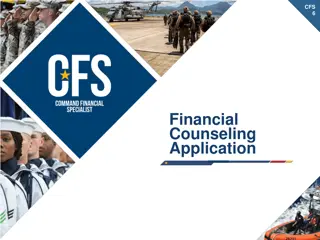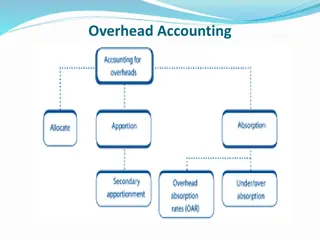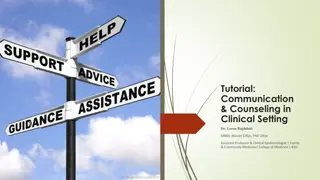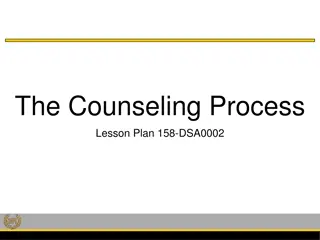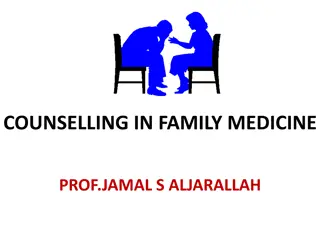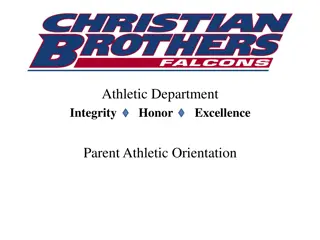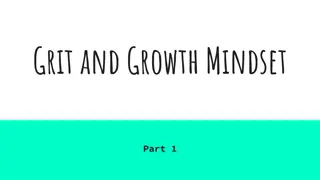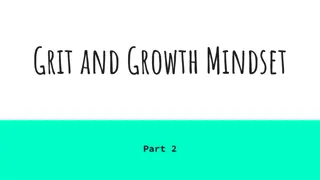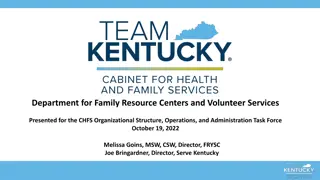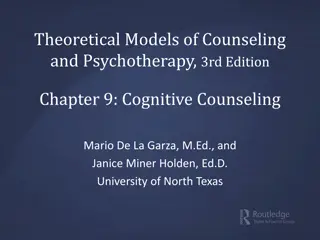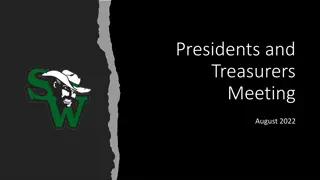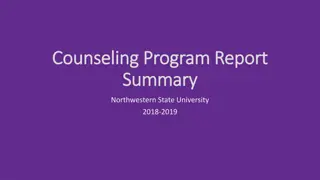Enhancing Team Grit: Bridging Counseling Centers and Athletic Departments
Explore efforts to improve inter-departmental relationships between counseling centers and athletic departments, addressing the unique needs of student-athletes. Learn about initiatives to enhance team grit through workshops and understand the differences in mindset and culture between student-athletes and the general college population. Discover the impact of mindset shifts, unintended consequences, and the importance of fostering a growth mindset in this dynamic environment.
Download Presentation

Please find below an Image/Link to download the presentation.
The content on the website is provided AS IS for your information and personal use only. It may not be sold, licensed, or shared on other websites without obtaining consent from the author.If you encounter any issues during the download, it is possible that the publisher has removed the file from their server.
You are allowed to download the files provided on this website for personal or commercial use, subject to the condition that they are used lawfully. All files are the property of their respective owners.
The content on the website is provided AS IS for your information and personal use only. It may not be sold, licensed, or shared on other websites without obtaining consent from the author.
E N D
Presentation Transcript
Breaking Down Barriers between Counseling Centers and Athletic Departments: My Efforts to Become an Ally and Improve Team Grit. BRITTANY HIGGINS, M. ED. UTICA COLLEGE
Purpose and Objectives: Discuss the difficulties of inter-departmental relationships (specifically) between counseling and athletics. Explore the differences between working with student-athletes and general college population (what makes that culture different). Discuss my attempt at increasing team Grit through a 10-week workshop that I designed and implemented across 6 different athletic teams.
Why is this important? At UC we have approximately 700 student-athletes. That makes up nearly 1/3 of our on campus students. Recent legislation passed in January 2019 for Power 5 Conferences Stats? Is it actually comparable to non student-athletes? Student-Athletes are different today- Coaches are asking for help
Phase 1: Understanding the Student- Athlete What is the culture of today s college student/student-athlete? What is their mindset?
Now vs. then When Where Training Equipment Uniforms Choosing sides Rules Refreshments Rewards for playing
Unintended Consequences Their world is full of Consequently, they can assume Speed Slow is bad Convenience Hard is bad Entertainment Boring is bad Nurture Risk is bad Entitlement Labor is bad
Fixed vs. Growth Mindset Fixed Mindset Growth Mindset Skills and talents are set Skills and talents are grown and can be developed You don t have control over your abilities You are in control of your abilities You can t learn and grow You can learn and grow
Phase 2: Understanding Athletic Department & Coaches How do they like to be communicated with? What are their expectations? History with Counseling Center on campus?
Phase 3: Reach out! Coaches don t typically have time to respond to emails. Unless you have their cell number, coaches are difficult to contact via phone. They are very protective of their athletes, teams, assistant-coaches and may be suspicious of you coming in. Appreciate clear and direct communication; however, it s important that you acknowledge their expertise, the difficulties of their job etc. in order to get buy in.
Phase 3 continued: Hello Coach ______, I hope the summer has been serving you well. I am reaching out to you because I have set a goal for myself to attend at least 1 practice of every sport this year. I would like to just very briefly introduce myself to the team with the goal that they gain a familiar face in the Counseling Center so it's easier to access in the future if need be. I would not want to take more than 2 minutes of your team's time. I would also love to stay and observe what your team does in a typical practice if you would allow for that, but I understand not every coach may be comfortable with that. I am flexible and happy to attend a typical practice, lifting session or whatever is convenient for you. Please let me know if your schedule allows for this. Best regards, Brittany
More of Phase 3 When email fails, get familiar with your athletic center and start knocking! Be a presence in your athletic facilities
Phase 4: Buy swag! Meet with the teams Introduce self, ask if they know how to access services, where you are located (always provide prizes if they know the answers) Follow up with thank you emails to coaches and request team roster Email team your contact information
Tips for reaching every team Make nice with your AD Every student-athlete has to attend a mandatory NCAA meeting prior to the start of their season. You can potentially meet several teams at once here if you can get to practices.
Phase 5: Workshop Based on Angela Duckworth s work on Grit 10 weeks, 15 minutes/session each week Pre and Post test to measure Grit Also measured overall team GPA and team conference results Initially offered to 4 teams in Fall Every team was also offered a continuation of services after workshop ended
Week 1: Introduction, consents, questions and pre-test Student Athlete Survey Section 1 Directions: Here are a number of statements that may or may not apply to you. When responding, think of how you compare to most people --not just the people you know well, but most people in the world. There are no right or wrong answers, so just answer honestly! Please mark one response per question. Questions include: (1) New ideas and projects sometimes distract me from previous ones (2) Setbacks don t discourage me (3) I have been obsessed with a certain idea or project for a short time but later lost interest (4) I am a hard worker (5) I often set a goal but later choose to pursue a different one (6) I have difficulty maintaining my focus on projects that take more than a few months to complete (7) I finish whatever I begin (8) I am diligent. The student-athletes were asked to rank these questions from Very much like me all the way down to Not like me at all.
Week 2: Introduction to Fixed vs. Growth mindset
Week 3: SMART Goals S- Specific M- Measurable A- Attainable R-Relevant* T- Time specific
Week 4: Brief introduction to CBT Thoughts Actions/Behaviors Feelings
Week 5: Ruth Larsons 30 Exercise Provided as a team
Week 6: Process What was it like when I asked you to make a list of 30 items? What was it like to give feedback to teammates? What was it like to receive feedback from teammates? How to keep this in mind?
Weeks 7-9: Visualization Week 7- General stress reduction visualization Week 8- Self esteem based Week 9- Sport specific (required some homework on my part)
Week 10: Debrief, feedback, post-test What was helpful? What did you like? What would you change? Heads up regarding survey being sent over email
How were coaches involved? Some were more involved than others When possible, I would include coaches on emails that I would send to the team reviewing information that was taught that week Other coaches wanted to chat briefly after the workshop Others preferred a phone call etc.
Other Outcomes Offered to approximately 230 athletes/7 teams (100 were Football alone) 143 Student-Athletes chose to participate in the data collection portion; however, many more participated in workshop Team s in Fall showed an increase in Grit Grit-TBD Huge increase in referrals!
Results: Fall Team GPA Overall Team GPA for Fall Teams 3.5 3.4 3.3 3.2 3.1 GPA 3 2.9 2.8 2.7 2.6 2.5 Fall 2013 Fall 2014 Fall 2015 Fall 2016 Fall 2017 Fall 2018 Semester Team A Team B Team C Team D
Spring Team GPA Overall Team GPA for Spring Teams 4 3.8 3.6 3.4 3.2 GPA 3 2.8 2.6 2.4 2.2 2 Spring 2014 Spring 2015 Spring 2016 Spring 2017 Spring 2018 Spring 2019 Semester Team E Team F
Conference Outcome- Mens/Womens XC 2013 2014 2015 2016 2017 2018 Men's XC 2nd 18th 5th 22nd 2nd 18th 4th 15th 3rd 21st 1st 19th Empire 8 finish NCAA finish 2013 2014 2015 2016 2017 2018 Women's XC 4th NA 5th 26th 5th 23rd 4th 23rd 1st 13th 1st 14th Empire 8 finish NCAA finish
Winning Percentage- Mens Soccer Men's Soccer Winning Percentage by Season 80 70 60 Winning Percentage 50 40 30 20 10 0 2013 2014 2015 2016 2017 2018 Season
Winning Percentage- Womens Soccer Women's Soccer Winning % 70 60 50 Winning Percentage 40 30 20 10 0 2013 2014 2015 2016 2017 2018 Season
Winning Percentage- Womens Basketball Women's Basketball Winning % 50 45 40 35 Winning Percentage 30 25 20 15 10 5 0 2014 2015 2016 2017 2018 2019 Season
Winning Percentage Womens Lacrosse Women's Lacrosse Winning % 80 70 60 Winning Percentage 50 40 30 20 10 0 2014 2015 2016 2017 2018 2019 Season



